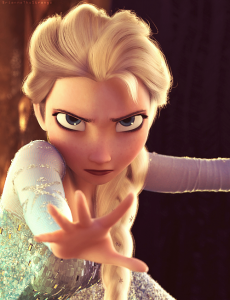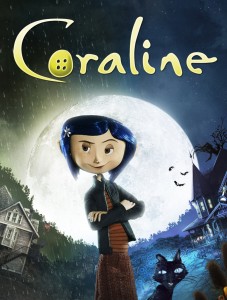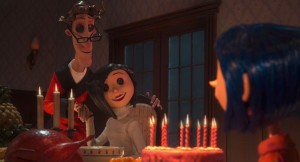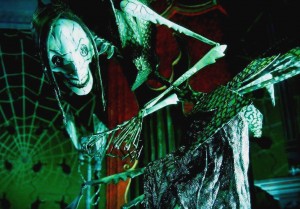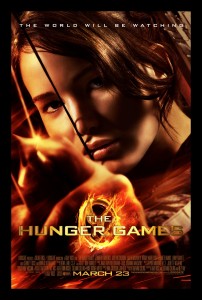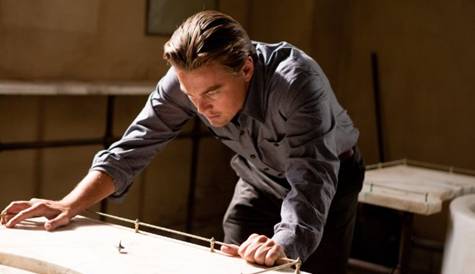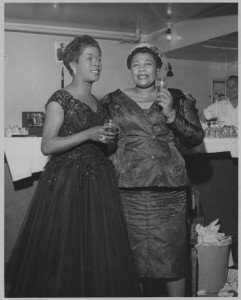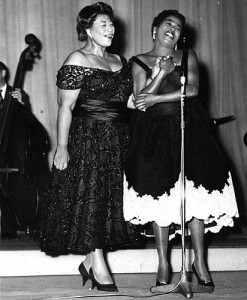Pop Quiz: Can you guess which of these three bands is The Beatles?



Nothing gets me more pumped up than waking up after a solid eight hours of sleep, making a steamy cup of peppermint tea, and putting my Spotify “Beatles” playlist on shuffle to start the day. The Beatles are on the top of my list, but this really should not be surprising because a loving the Beatles is far from unusual. While I am convinced that I have a genuine admiration for their work, it seems like everyone else feels a similar sense of admiration, considering that in nearly every “100 Best Artist” or “Top Musicians of All Time” list there is bound to be a Beatle. Rolling Stone called them “one of the best things to happen in the twentieth century”(1), while MTV stated that they were the “most influential act of the rock era, and introduced more innovations into popular music than any other rock band of the 20th century.”(2) Even CNN, a news source that goes beyond just reporting entertainment related news, claimed that, early on, The Beatles were set on a “history making path of pop-culture dominance.”(3) Classics like “Yesterday” and “Let It Be” grace the lives of nearly anyone knowledgable of pop-culture, while songs like “Octopuses Garden” and “Yellow Submarine” are childhood classics. There is no denying the special place The Beatles claims in the hearts of millions of people around the world. For many of these people, The Beatles are truly sentimental, a musical reminder of bonding time with mom and dad, classic college kickbacks, or, to some older fans, the craziness of the ‘60s.
But, with the sense familiarity of nearly every Beatles song that comes with being a fan, is the is the inevitable need to ignore the indisputable reality of the Beatle’s music being far from unique when further observed. As a Beatles fan myself, it is easy to recognize the variety of music and the so called “innovation” that so many music critics accredit to the band, but this notion of individuality does not hold up. Innumerable people are quick to jump on to the “Beatles are the best” bandwagon, and fail to recognize the contradiction of the notion they often accept. This contradiction lies in the false idea, so commonly advocated by Beatles supporters, that the band broke the system of artists forced to fit into molds created by pop culture. In fact, this perception of them as “mold-breakers” can be seen as the exact opposite of the reason for their success. If one were to attribute their success and popularity for years beyond their break up to one thing, it would be the fact that they embraced the culture industry and learned to manipulate popular molds to their benefit. To build The Beatles up as “the best” off of the inaccurate perception of them being extraordinarily unique signifies a lack of knowledge of their music, the music of the era, and of their relationship with the culture created by the music industry. We must ask ourselves: were they really a band to have influenced pop-culture, or was pop-culture influencing them?(4) The answer is both. It is time to accept that the adorable bowl haircuts, the cool India-inspired garb, the aggressive guitar riffs and loving ballads were all trends that The Beatles adopted and then promoted, contributing to a cycle of sharing fads. The Beatles were an amazing band, and inspired many future artists, but their admirability lays in something beyond uniqueness. If people just opened their eyes and ears, and took away any pre-supposed biases towards the band, it would quickly become clear just how blinded we have become by admiration. But who can blame the fab four for contributing to the consumer industry’s tendency to homogenize musical themes. After all, with respect to popular musicians, “everyone is doing it.”
Their early career marked the beginning of this cycle of pop music production. The Beatles, known in their formative years as the “Quarrymen”, started their performing career by playing covers of songs popular at the time, a selection of artists ranging from The Del-Vikings, to Big Mama Thorton, to Buddy Holly.(5) In fact, it was a Buddy Holly song, “That’ll be the day” that inspired The Quarrymen’s first recording. In addition to having covered the songs of Buddy Holly, the band was also inspired partially by Holly’s partner band, The Crickets, to name themselves “The Silver Beetles” (which was short lived as the Beat movement inspired the men to soon change their name to “The Beatles”.) Thus marks the first big movement of the band borrowing trends and themes from already popular influences.
As the band gained fame they made big changes to their group dynamic, starting with their appearance. Playing in the grungy pubs in their hometown of Liverpool and then later in larger clubs in Hamburg, the boys had initially adopted the 1960’s “Rocker” look, complete with greased up hair and leather jackets that had become so popular amongst many English youth in the 1960’s (left). In the wake of their movement toward up-and-coming fame, however, they decided to compromise between the “rocker” look and the more conservative “mod” look, and molded themselves into a more clean cut boy band (think One Direction meets ‘60s businessman), while keeping a “Rocker” edge to their music (right).
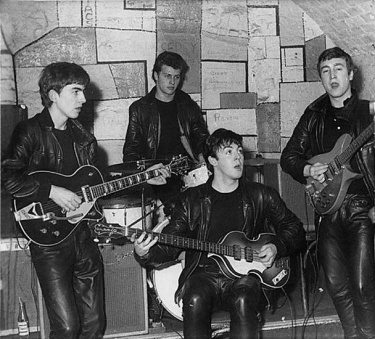

While their look may have changed during their beginning stages of fame, their sound certainly did not. Although they began to write many of their own songs, something that is not seen so often today, their songs followed the style of what was popular at the time. Their song “Twist and Shout”, for example, instantly reminds me of Chubby Checker’s song “The Twist”(1960), as it shares a similar uplifting danceable beat as well as the message to dance “The Twist”. “I Will” has a similar serenading melody to “Only the Lonely” by Roy Orbison (1961). A personal favorite of mine, “Please Mr. Postman” from the album With The Beatles (which became the number one album in the UK), did not just share themes with other songs, but was, in fact, a cover of a song original sung by The Marvelettes.
The Beatles continued this trend of evoking popular music themes of the time leading up to their debut on the Ed Sullivan show in America, staying within the stylistic range they had built their fame upon. That is one of the things that makes The Beatles so easy to listen to, if you are feeling like listening to something with a sound similar to “I Want To Hold Your Hand”, all you have to do is pick out a song from the very same album! Even right after the rise of “Beatlemania” they continued to play on the safe side and produce music with themes that were successful in their earlier pieces. But then, in 1964 the band released Beatles For Sale which introduced a new element to their music, a sort of classic blues-inspired “American” twist on their work, with Paul McCartney leading “wild and hoarse” vocals on a medley on another cover, this time of “Kansas City [Jerry Leiber and Mike Stoller]/ Hey-Hey-Hey [Little Richard].”(6) In their next couple albums, they followed a similar suite of incorporating newer trends, slowly becoming a little more open to more influences from the lesser known parts of pop-culture.
A great example of this is Revolver, the album that many fans consider a major turning point in The Beatles career, marked the point at which their introduction of little elements turned into experimenting with new undiscovered styles and setting the trends themselves. So many fans, including myself, turn to Revolver as an example of how The Beatles “…were ground-breaking pioneers.”(7) “Elenor Rigby”, one of the hit songs of the album, introduced a new aspect to The Beatles sound, an abstract orchestral-style background and modern experimental sounds. While some bands had already started to tinker with this, such as a young and yet-to-be famous Pink Floyd with their lead singer Syd Barret, or the Yard Birds, The Beatles had the established status in the music world and were able to produce and popularize songs with such techniques. Their status provided them with the opportunity to take what some lesser-known bands had been doing for years, and create a new pop fad out of it. Thus marks the second step in the cycle of popular music production the culture industry promotes so well, giving influential artists the power to set the stage for new trends. While they never truly innovated by producing a completely new sound, The Beatles managed to use their power in the music world to incorporate musical themes they found attractive into their pieces, popularizing them, and as a result providing a basis of pop-culture from which many later bands would find their inspiration.
The Beatle’s evolution of personal style and appearance within their role as cultural figures, visible especially during and after their album Sgt. Pepper’s Lonely Hearts Club Band was simply a naturally timed adaption to keep up with the music industry. They were merely adopting new fads and trends from other cultural areas at the time. Their experimentation with LSD, often an event that is credited context for their sudden change in music style, fell around the time that many other artists, The Doors’ Jim Morrison and even Pink Floyd’s Syd Barret, who had been using the drug well before The Beatles. However, as one of the most popular bands of the time, with a huge fan base, their psychedelic style and music as a result of their experimentation with drugs set trends in pop-culture that were soon adopted by others, just as The Beatles had done before their rise to power, by bands like David Gilmour fronted-Pink Floyd.
The Beatles also experimented widely with instruments not typically associated with “rock stars”, eventually incorporating these instruments into their art as well. As a sense of out-worldliness grew amongst the youth in the UK as well as the United States, so did this expression grow in The Beatles music. The sitar, an instrument that was traditionally played in India and favored largely by George Harrison, as well as what many call Indian inspired melodies, became reoccurring features in their songs, especially from the album Revolver and beyond. The Doors, at this time, began to emulate this, playing in a style similar to The Beatles India-inspired rock, as heard in the Door’s song “The End.” In addition, The Doors, in songs like “Riders of the Storm”, amongst other bands including The Kinks and The Animals, also adopted the bluesy rock style that The Beatles had once incorporated, with songs like “I Want You (She’s So Heavy)” and “For You Blue.” In addition to the bluesy sounds, other bands also adopted a polarity in their identity as artists, as they looked one way in appearance and played their music another way, as The Beatles had done years before. The Animals, as mentioned before, not only sounded like The Beatles, but they tried to look like them too, playing their rock and roll in preppy, carefully tailored gray and yellow suits. Even if The Beatles could be attributed with being the source of certain fads, they can not be called unique for the very reason seen with The Animals. These ideas that The Beatles popularized already existed, it was just their adoption of them that turned them into fads, and called many up and coming musicians to do the same. The more new things The Beatles popularized, the more other bands copied them, and the more homogeneity was visible in the music industry.
At this final point in their career, with fame heightened to its maximum, it is safe to say The Beatles went from artists shaped by the demands of consumers of pop culture to artists helping shape pop culture and what was demanded. While their innovations were not quite innovations in the sense that they were borrowed, The Beatles had their predominant fame help them turn unpopular occurrences into themes in music that became mass produced.
For a fan such as myself, I can not let these facts discourage me from being supportive of my favorite band. But their so called “uniqueness” is not a valid reason to call them the best. They were the best in the way that they gave the people what they wanted, in the way that they created art that moved the masses. The Beatles were talented for understanding the culture of the time, and later recognizing unrecognized techniques and styles to bring to the public eye. Contrary to being unique, they facilitated homogeneity in musical themes. This, as pessimistic as it sounds, is not meant to cast The Beatles in a dark light, but instead praise them as masters of the 20th century mass production of music and the “rock star” movement. The band learned to take different music scenes and cultural styles and adapt their sounds to fit in with their surroundings, creating what people of the time felt was the most pleasurable to listen to. The ability to create this pop music exchange better than anyone else left them as one of the most beloved bands of all time. In reality, these cute clean-cut boy band characters that children and adults alike loved, were really sneaky but lovable musicians (and opportunist) playing on the heart strings of the consumers of popular culture.
1)George-Warren, Holly, Patricia Romanowski Bashe, and Jon Pareles. The Beatles. The Rolling Stone Encyclopedia of Rock & Roll. New York: Fireside, 2001. N. pag. Web. <http://www.rollingstone.com/music/artists/the-beatles/biography>.
2)”About The Beatles.” MTV Artists. MTV, n.d. Web. <http://www.mtv.com/artists/the-beatles/>.
3)Leopold, Todd. “5 Things to Know About Beatlemania.” CNN. Cable News Network, 25 Aug. 2014. Web. 18 Mar. 2016. <http://www.cnn.com/2014/01/30/showbiz/beatles-ed-sullivan-beatlemania-5-things/>.
4)Adorno, T. & Horkheimer, M., 1944. The Culture Industry: Enlightenment as Mass Deception. In T. Adorno and M. Horkheimer. Dialectics of Enlightenment. Translated by John Cumming. New York: Herder and Herder, 1972.
5)“Artists Covered by The Quarrymen.” The Quarrymen Covered Songs and Artists. Samsung, n.d. Web. 18 Mar. 2016. <http://www.setlist.fm/stats/covers/the-quarrymen-3bd6883c.html>.
6)“Kansas City/Hey-Hey-Hey-Hey! | The Beatles Bible.” The Beatles Bible. N.p., n.d. Web. 18 Mar. 2016. <http://www.beatlesbible.com/songs/kansas-city-hey-hey-hey-hey/>.
7) Lee, Peter. “20 Reasons The Beatles Are the Greatest Band Ever.” Hooks & Harmony. N.p., 29 June 2008. Web. <http://www.hooksandharmony.com/20-reasons-beatles-greatest-ever/>.

